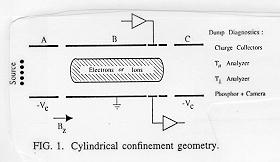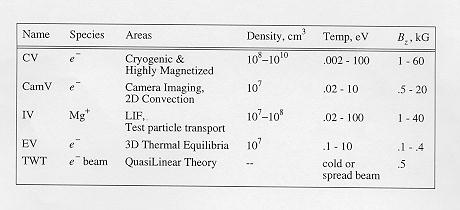


Figure 1 shows the cylindrical confinement geometry used for electron or ion confinement;
a typical apparatus actually has 10-15 electrodes, rather than the 3 shown. Radial confinement
of the plasma is provided by a uniform magnetic field Bz. The conducting cylindrical wall
is divided into sections, with the plasma normally residing in the grounded central section.
The end sections are biased sufficiently negatively (or positively) that axial confinement of
the electron (or ion) plasma is assured. The plasma is rotating, since the radial electric
field due to space charge gives an ExB drift in the  direction. Electrons are obtained from a
hot filament, ions from an arc on a magnesium electrode.
direction. Electrons are obtained from a
hot filament, ions from an arc on a magnesium electrode.
The system is operated in an inject/hold/dump cycle. During the hold phase, the trapped particles may be transported across the field by various processes: some reach the wall and are absorbed. During this time charge density fluctuations are detected by amplifiers connected to isolated sections of the wall, and the plasma can be manipulated by applying voltages to such sectors. Additionally, on the IV apparatus only, a laser beam is used to measure the density n(r,z,t) and the velocity distributions F_perp(r,z,t) and F_parr(r,z,t).

A variable time (t) after injection, cylinder c is gated to ground, dumping the remaining particles out that end. The dumped charge is measured either with moveable and fixed Faraday cup collectors, or with a phosphor imaged by a CCD camera (CamV). The electron temperature T is obtained by decreasing the confinement voltages and measuring the electrons which are energetic enough to escape.
The experimental diagnostics allow accurate measurement of all of the macroscopic plasma
characteristics. The full 3D electron density n(r, ,z,t) is obtained by measuring
the z-integrated charge density ñ(r,
,z,t) is obtained by measuring
the z-integrated charge density ñ(r, ,t), presuming a Boltzmann distribution
along the field lines, and then solving the 3D Poisson's equation with the known boundary
conditions. Although specific unstable density profiles can be generated, normal operation
of our apparatus results in a relatively quiescent plasma. Further, the injection conditions
are typically reproducible from shot-to-shot within a few percent.
,t), presuming a Boltzmann distribution
along the field lines, and then solving the 3D Poisson's equation with the known boundary
conditions. Although specific unstable density profiles can be generated, normal operation
of our apparatus results in a relatively quiescent plasma. Further, the injection conditions
are typically reproducible from shot-to-shot within a few percent.
The dispersion relation for electron plasma waves in a non-neutral plasma is the same as it
is in a neutral plasma, except for the doppler shift due to the ExB rotation of the
non-neutral plasma. Here, we consider perturbations varying as exp(im +ikz-i
+ikz-i t).
We have performed measurements on wave dispersion, Landau damping, and trapping in a large
amplitude m=0 wave, both to test the theories and to obtain information about the
plasma sample. We have also extensively studied the properties of k=0 "diocotron" waves
in the trapped plasma. Here, the wave motion occurs solely due to
ExB drifts.Waves with angular dependence m=1,2,3 have been unambiguously
identified and studied.
t).
We have performed measurements on wave dispersion, Landau damping, and trapping in a large
amplitude m=0 wave, both to test the theories and to obtain information about the
plasma sample. We have also extensively studied the properties of k=0 "diocotron" waves
in the trapped plasma. Here, the wave motion occurs solely due to
ExB drifts.Waves with angular dependence m=1,2,3 have been unambiguously
identified and studied.